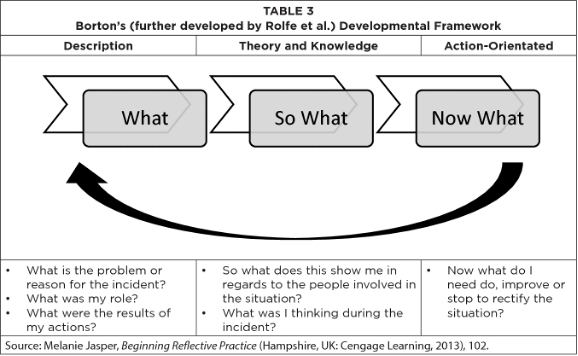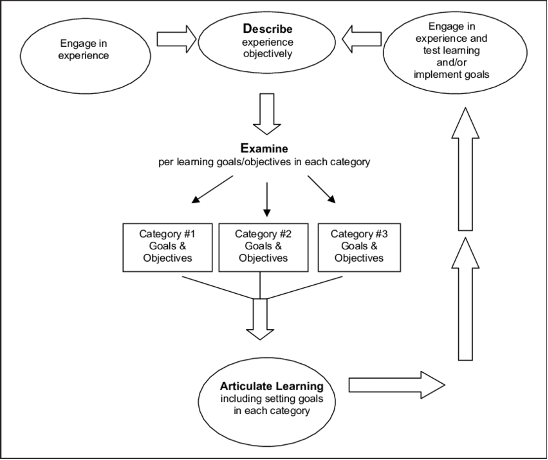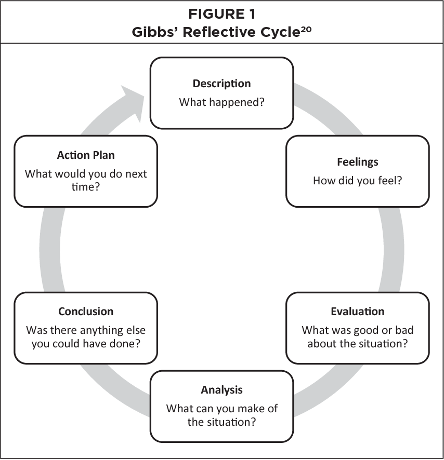Constructing Reflection Prompts to Promote Critical Reflection
by Michelle Head, CETL Scholarly Teaching Fellow for Reflective Practices
This article is part of the larger, Reflective Practices for Teaching.
No matter the type of reflection practice you choose to employ in your classroom, it centers on the quality of the reflection prompt provided to the students.
There are a number of reflection frameworks that can be used to guide a student towards critical reflection. Each of the ones below have been used with a variety of learning experiences.
The So What? Reflection Model
The So What? Model has been attributed in the literature to folks including Driscoll, Borton, and Rolfe.

What?
Can you identify a problem or obstacle that stands out to from your time at your internship? (It is helpful to identify or briefly describe a specific scene/situation to explain)
So What?
What about this situation stood out to you from a sociological perspective? (Did you feel concerned or troubled by it, maybe uncomfortable? This may help you think about what about it was raised your discomfort. Try to engage with your sociological training as you think about it.)
Now What?
How might the situation/scene have been handled differently? Was any sort of change
to the situation under your control/ability to change? After the scene how were you
changed? Did you do things different after? Speak to a supervisor or colleague? What
have you learned from this that you can use moving forward (in school, professional,
what-have-you)?
The DEAL (Describe, Examine, Articulate Learning) Model

Sample reflection assignments from an undergraduate research course:
-
Assignment 1 (after Day 1 of data collection in the field)
- Briefly describe the experience – Where did it take place? What happened?
- Did you encounter any problems? What types? How did you respond?
- Do you have any apprehensions based on learning about conducting research and/or survey techniques?
- Was the information you learned in class helpful during data collection? How so?
-
Assignment 2 (after Day 2 of data collection)
- Briefly describe the experience – Where did it take place? What happened?
- Did you make any changes to your technique from Day 1? Why? What was the outcome?
- How did your experience collecting data compare to your initial expectation for the course?
- How did your experience collecting data compare to what you learned in the course about survey techniques? Was the information learned in class helpful? How so?
-
Final Reflection
(We also have an in-class discussion to reflect on the experience prior to the due date for this to help guide.)
Directions: Consider your entire experience in this class. Address each of the prompts below incorporating both your in-class and data collection experiences. Think about how the course material learned in class tied in with data collection and your overall thoughts about the course. You may want to reference class readings when discussing how all of the information ties together.
- What did I learn...
- How did I learn it…
- Why does it matter…
- What I will do in light of it…
The Gibbs Reflective Cycle

Think back to a time when you felt like an outsider and needed to interact with people to complete a task. This could be an example from work, school, etc. Your outsider status can be based on any characteristic you find relevant. Reflect on the following questions:
- What were the situation and task? (description)
- How did you feel like an outsider? (feelings)
- What were some obstacles and frustrations you encountered? Where do you think these came from? (evaluation / analysis)
- How do you think others perceived you, and how did you get these ideas? (evaluation / analysis)
- How did you perceive others, and how did you form these impressions? (evaluation / analysis)
- How did these varied perceptions impact getting the task accomplished? Did they serve or detract from accomplishing the task? (conclusion)
- How could you have productively shifted your perspective and interpretation of the situation? How would this have changed your course of action? (action plan)
References
Ash, S. L., & Clayton, P. H. (2009). Generating, deepening, and documenting learning: The power of critical reflection in applied learning. Journal of Applied Learning in Higher Education, 1(1), 25-48.
Gibbs G (1988). Learning by Doing: A guide to teaching and learning methods. Further Education Unit. Oxford Polytechnic: Oxford.
Jasper, M. (2013). Beginning reflective practice. Andover: Cengage Learning.
back to reflective practices











